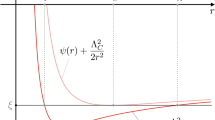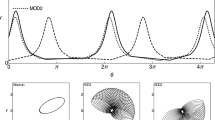Abstract
Particle trajectories in different Spherically Symmetric static space-time metrics are studied employing Pseudo Newtonian potential (PNP).
Access provided by CONRICYT-eBooks. Download conference paper PDF
Similar content being viewed by others
209.1 Introduction
The Pseudo-Newtonian Potentials (PNPs), which are constructed/proposed to replicate few general relativistics features approximately in Newtonian framework, are often used to study inner relativistic dynamics of the accretion flow around spacetime geometries describing black holes. For a general class of static spherically symmetric space time metrics \(ds^2 =-f(r)^\beta \, c^2 \, dt^2 + \frac{1}{f(r)^\beta } \, dr^2 + f(r)^{1-\beta } r^2 d\Omega ^2 \, ,\) where f(r) is the generic metric function, \(\beta \) is an arbitrary constant parameter, the PNP can be written as [1]
The particle trajectories can be obtained by solving the Lagrangian equations for the potential given in (209.1). In the below, we studied particle trajectories for a well known naked sigularity spacetime - Janis-Newman-Winicour (JNW) metric for which \(\beta =\gamma \) and \(f(r)= 1- \frac{2r_s}{\gamma r}\) where, \(0 < \gamma \le 1\). The geodesic equations are
and
For particle dynamics along circular orbit, \(\dot{r}=0\) and \(\ddot{r}=0\). The particle trajectories obtained by solving (209.2)–(209.3) are shown in Fig. 209.1.
Comparison of elliptic like trajectories of particle orbit in equatorial plane in JNW spacetime with those in Schwarzschild and Newtonian cases projected in the x-y plane. Solid and short-dashed lines corresponding to Newtonian and Schwarzschild cases, respectively. Long dotted-dashed curve in Fig. 209.1a, b, c, d, e, f are for \(\gamma = 0.2, 0.3, 0.4, 0.5, 0.7, 0.95\), respectively. The particle starts from apogee with \(r_a = 40 r_s\) with \(v_x = 0.0\) and \(v_y \equiv v_\mathrm{in} = 0.092\) (in units of c). For \(\gamma < 0.2\), no proper well defined elliptic like orbits exist with the orbital parameters chosen here
209.2 Conclusions
The test particle dynamics along circular orbit in JNW space-time departs to those in Schwarzschild geometry. The stated deviation is larger for smaller \(\gamma \).
References
S. Ghosh, T. Sarkar, A. Bhadra, Phys. Rev. D 90, 063008 (2015)
E. Tejeda, S. Rosswog, MNRAS 433, 1930 (2013)
E. Tejeda, S. Rosswog (2014), arXiv:1402.1171v1
T. Sarkar, S. Ghosh, A. Bhadra, Phys. Rev. D 92, 083010 (2014)
Author information
Authors and Affiliations
Corresponding author
Editor information
Editors and Affiliations
Rights and permissions
Copyright information
© 2018 Springer International Publishing AG, part of Springer Nature
About this paper
Cite this paper
Sarkar, T., Bhadra, A. (2018). Orbital Dynamics Using Pseudo-Newtonian Potential. In: Naimuddin, M. (eds) XXII DAE High Energy Physics Symposium . Springer Proceedings in Physics, vol 203. Springer, Cham. https://doi.org/10.1007/978-3-319-73171-1_209
Download citation
DOI: https://doi.org/10.1007/978-3-319-73171-1_209
Published:
Publisher Name: Springer, Cham
Print ISBN: 978-3-319-73170-4
Online ISBN: 978-3-319-73171-1
eBook Packages: Physics and AstronomyPhysics and Astronomy (R0)





